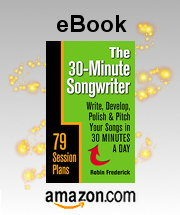We all run into songwriting problems from time to time. Solving that problem quickly and moving on is the key to growing you song catalogue, saving time, and getting your work out there to listeners. You can use the 30-Minute Songwriting session technique to quickly get the solutions you need and get your songs moving again.
Read Part 1 and Part 2 in this series on 30-Minute Songwriting sessions to get familiar with this incredibly useful technique.
Note that in these sessions I suggest that you use hit songs as reference songs to help you find the answers. Don’t copy the hit song. Instead, use the techniques you find and adapt them to your own style and song.
Songwriting Problem: Dated lyrics
◆ Give your lyrics a contemporary flair (30 min.)
Today’s hit songs feature very rhythmical lyric lines that weave in and out of the underlying steady beat of the song. If you’re writing Pop, Dance/Pop, or even Country or Singer-Songwriter, it’s a good idea to get familiar with rhythmical lyric writing.
Find and print out the lyrics to a Pop hit like Charlie Puth’s “Attention” or Alessia Cara’s “Stay.” Or try this with a Country hit like Thomas Rhett’s “Look What God Gave Her.”
You want to get a feel for the rhythm of the lyric and how it relates to the beat. Talk-sing the words or use nonsense syllables without worrying about the note pitches. Clap or tap your foot to the beat as you get familiar with the rhythm of the lyric, then try it without playing the hit song.
Songwriting Problem: Melodies all sound the same
◆ Get out of a melody rut (30 min.)
Do you find yourself writing the same chorus melodies over and over? Are you using the same rising melody at the end of every pre-chorus? Do your verse melodies all sound alike? If so, then you’re stuck in a melody rut. Time to solve that problem.
In a 30-minute session, listen to the chorus melodies of at least two recent hit songs in a style you want to write in.
- Notice which parts of the melody are repeated and where.
- Notice where the melody rises and falls.
- Is there a pattern of short and long phrases? What is the pattern?
- How does the melody in the first line of the chorus?
- How does the melody draw attention to the payoff (last) line?
Now, try writing a chorus melody of your own using some of these techniques: repetition, patterns of long and short phrases, attention-getting first and last lines.
Learning a new skill from a hit song or successful Film & TV song is something you can do in 30 minutes.
Keep it going
Just about anything can be broken down into manageable 30-minute bits. The trick is to work at it every single day. Don’t blow all your energy on a mega-workout one day, then stay in bed the next. Build superior, long-lasting strength with a daily routine. You can do it! Now, drop and give me thirty.

